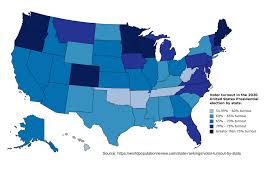How Race Affects Voting Patterns in US Elections
Historical Context and Its Impact
In the United States, the relationship between race and voting patterns has deep historical roots. For centuries, racial minorities, particularly African Americans, have faced systemic barriers to voting. These barriers included literacy tests, poll taxes, and other discriminatory practices designed to disenfranchise non-white voters.
The landmark Voting Rights Act of 1965 was a crucial turning point. This law aimed to eliminate racial discrimination in voting. It banned literacy tests and other practices that were used to deny the vote to minorities. Despite these advances, the effects of historical disenfranchisement still linger. Racial minorities often face different challenges and barriers when it comes to voting, which can influence their voting patterns today.
Voter Turnout Among Different Racial Groups
Voter turnout varies significantly among different racial groups in the U.S. Historically, African Americans, Latinos, and Asian Americans have had lower turnout rates compared to white voters. Several factors contribute to this disparity.
Economic and social factors play a big role. Many minority communities face economic challenges that can affect their ability to vote. For instance, they may have less flexible work schedules or face transportation issues. Additionally, some minorities may feel disillusioned or distrustful of the political system due to past experiences of discrimination or marginalization.
Efforts to increase voter turnout among these groups include targeted outreach and education campaigns. Organizations and community groups often work to address these barriers by providing resources and support to help increase participation.
The Role of Political Parties and Campaigns
Political parties and campaigns often tailor their messages to appeal to different racial groups. Understanding and addressing the concerns of specific communities can be a strategic move. For example, campaigns might focus on issues like immigration reform when appealing to Latino voters or criminal justice reform when appealing to African American voters.
However, this targeting can also have drawbacks. Sometimes, it can lead to the perception that political parties are only interested in certain groups during election seasons and not genuinely committed to their issues. This perception can impact voter trust and engagement.
The Influence of Media and Representation

Media plays a significant role in shaping perceptions of race and politics. Representation in media can influence how different racial groups are perceived and how they perceive themselves within the political landscape. Positive and accurate representation can boost political engagement and empower communities.
Conversely, negative or biased portrayals can reinforce stereotypes and discourage participation. The media’s framing of issues can also influence how different racial groups perceive the importance of various policies and candidates.
The Impact of Recent Voting Laws and Policies
Recent changes in voting laws and policies have had significant impacts on voting patterns among racial minorities. For example, some states have introduced stricter voter ID laws, which can disproportionately affect minority voters who may face challenges in obtaining the required identification.
Additionally, changes to voting methods, such as reduced early voting periods or the elimination of same-day registration, can also impact minority voter turnout. Advocacy groups often work to challenge these changes and ensure that voting remains accessible for everyone.
Future Trends and Predictions
Looking ahead, several trends could shape how race affects voting patterns in future elections. Increasing diversity within the U.S. population is likely to influence voting behaviors and preferences. As younger, more diverse voters become a larger part of the electorate, their values and priorities will play a significant role in shaping future elections.
Political parties and candidates will need to adapt to these changes by addressing the evolving needs and concerns of a more diverse electorate. Engaging with different racial communities and addressing their unique issues will be crucial for future success in elections.
Conclusion
Race plays a significant role in shaping voting patterns in the U.S. Understanding the historical context, current challenges, and future trends is essential for recognizing how different racial groups engage with the political system. By addressing barriers to voting and fostering genuine engagement with diverse communities, it’s possible to create a more inclusive and representative democracy.










